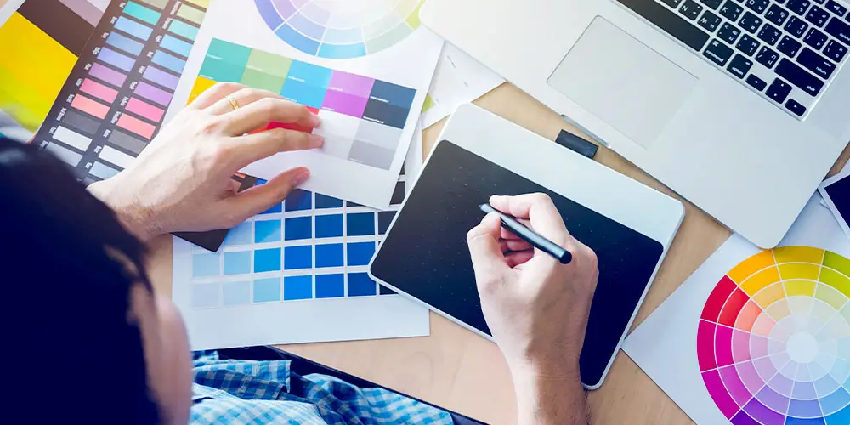
Eight graphic design tips for non-designers
When we are not designers, what discourages us is that when we try to create the first sketch, we usually do not like it at all. why? There are several reasons: it doesn’t look professional, it’s not what you were looking for, you don’t get harmony between the elements, and, sometimes (even worse), we have no idea how to start. calm down! That barrier is for all non-designers.
Now, if you like colors, aesthetics, and creating content, but you are not a professional, we bring you 8 graphic design tips for non-designers. Maybe you can become one by being inspired by this blog.
Learn About The Basics Of Graphic Design

Before starting to design it is important to start from the basics so as not to get lost along the way. Therefore, knowing the basics of graphic design can be of great help to non-designers when putting an idea on the canvas.
Graphic design has a wide range of branches and objectives, including web design, editorial, advertising, photography, illustration, visual identity, packaging, UX, and more. Identify which one you are in.
Know The General Concepts
In general terms, graphic design has fundamental bases in its development. Some of them are:
- Point: The basic communication unit par excellence. They can be a reference to beginnings and endings in a line, starting points, and vanishing points.
- Line: It is the union of several points, which gives a sensation of movement, direction, trajectory, and depth. It can also be used to create outlines, basic figures that in turn become more complex objects.
- Composition: When we speak of composition we refer to the way of structuring and arranging the elements within a space, it can be in a photograph, in a painting, montage, among others. So that a certain order, balance, and visual harmony is generated.
- Typography: To choose the font style (if your design requires it), you need to know what you are going to communicate, in what tone, and on what channel. If you want to express a neutral tone, plain, flat letters might help. You can compare fonts at DaFont (free fonts). In addition, we recommend that you do not use more than two fonts and combine styles, which can cause confusion and low legibility in your designs.
- Colors: For colors to exist, light must exist. This allows us to distinguish some objects from others and identify color variations.
You can identify colors as:
- Primary light colors, “RGB” ( red, green, blue ). It is used for digital designs since they are special for screens and monitors.
- Primary pigment colors, «CMYK» ( cyan, magenta, yellow and black « key », in English). It is used for prints.
It is important to know that each color conveys a message. For example, blue sadness means a dull and “lifeless” context, however, this color can also convey a message of luxury or seriousness if turned into a darker shade. It all depends on the context and the purpose (selling, transmitting an emotion, among others).
Look For Ideas And Get Inspired
Taking inspiration from artists, designers, and visual communicators can help you bring wonderful ideas to life. So do not stay with the first image that comes to your head, exploit your imagination to the fullest and take references to enhance your designs. Little by little you will find your style and personal touch.
Some of the graphic design pages where non-designers can find this inspiration are Behance, Pinterest, Instagram, Abduzeedo, and Create by Adobe, among others.
After getting inspired, analyzing styles, polishing the idea, and working on its structure, it’s time to conceptualize it and bring it to a first draft. You can capture this through a mood board or canvas in which you will place reference images, styles, color palettes, concepts, and other elements that help to better understand the idea.
Trace Your First Sketches
Once you have the idea concretized and you know 100% what you want to convey, you will start the sketching process (it can be tedious, but it will give you better results). Here you will capture the first facets of your design. You can start them on a sheet and paper, and then transfer those sketches to digital.
Many times the first sketch is the one that remains in the final version, however, it is good to have other variations on the design, as this can inspire new ideas for future work.
Find Design Apps That Could Help You
There are countless software and design applications. Be careful, this will depend a lot on the quality and purpose of the work to be presented.
One of the best-known apps for intuitive, easy, and fast graphic design is Canva. On the contrary, if you want a high-quality vector or pixel design, either for a project or to create content, we recommend using Photoshop, Illustrator, InDesign (layout for magazines, books…), or others. It all depends on your goal.
Use Free Resources
Remember that when uploading visual content to social networks, web pages, or other communication channels, if you are not careful with copyright, your design can be removed, or in serious cases, you could be accused of plagiarism. Therefore, it is important that you use images, illustrations, stickers, fonts, or other elements that are free to use.
This is one of the graphic design tips for non-designers that you should never skip (for the world).
We leave you some pages to download copyright-free images:
- pixabay
- pixels
- Freepik
- FreeImages
- unsplash
Use The Right Formats
An important step before and after making any design is to determine the channel that the design will be in. This will help you to know the dimensions, the format, and the specifications that (social networks, web pages, impressions, among others) ask for to share them, and in turn, visualize it correctly on the screen of a computer or cell phone.
Keep Practicing And Learning
Whether you start studying graphic design, learn independently or catch your eye, perseverance will be a great ally. We recommend you to continue inspiring yourself, sketching, and practicing.
You may like to read Tips for fabulous label and packaging design

Sorry, the comment form is closed at this time.